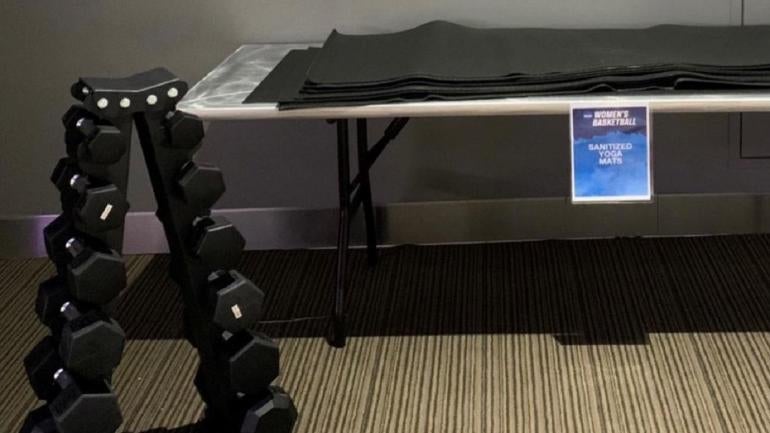
On Thursday, images that Stanford sports performance coach Ali Kerschner posted on social media displayed a drastic difference between what men's teams competing at the NCAA Tournament in Indiana get to use to work out and what the women competing at the NCAA Tournament get in Texas.
The image of the men's gym in Indy shows numerous dumbbells, workout benches, weight racks, and bars and plates in a rather large workout space that's comparable to an average gym. The image of the women's gym, meanwhile, has six pairs of weights total and some sanitized yoga mats -- the latter of which was labeled with NCAA Women's Basketball branding. New York Liberty guard and former Oregon Ducks superstar Sabrina Ionescu helped bring further attention to this disparity through Twitter.
Women’s @NCAA bubble weight room vs Men’s weight room... thought this was a joke. WTF is this?!?
— Sabrina Ionescu (@sabrina_i20) March 18, 2021
To all the women playing in the @marchmadness tournament, keep grinding! pic.twitter.com/K04KTv6s46
As these images gained steam on social media, the NCAA eventually released a statement saying that the significantly smaller women's gym was a result of "limited space" and there were plans to make that area larger once more teams got eliminated as the tournament went on.
We acknowledge that some of the amenities teams would typically have access to have not been in place as available inside the controlled environment. In part, this is due to the limited space and the original plan was to expand the workout area once additional space was available later in the tournament. However, we want to be responsive to the needs of our participating teams, and we are actively working to enhance existing resources at practice courts, including additional weight training equipment.
But some took issue with the NCAA's statement, particularly the portion regarding limited space in the area. One of those who did was Will Abrams, the Director of Player Development for Rutgers women's basketball, who showed a video of a rather empty large room with one practice court, implying that there actually was space for a larger gym. This was also hammered home by Kendric Lindsey, a digital content creator for University of South Carolina women's basketball.
“Not enough space” https://t.co/ZCKLuXpPmb pic.twitter.com/WvDGYdFQhy
— Will Abrams (@CoachWillRU) March 18, 2021
One rack of dumbbells for women vs a whole planet fitness for the men. Women’s basketball stays getting disrespected. https://t.co/uRoA7Ph3yF pic.twitter.com/UMm37i5Q15
— kdot (@kendriclindsey) March 18, 2021
But moving beyond the current inadequate set up, it seems that the NCAA's promise of a larger gym for teams that advance in the tournament doesn't hold too much water either. As Chantel Jennings of The Athletic pointed out, the amenities offered to teams making the Sweet Sixteen don't seem to match up to the number of players that will be playing at that point in the tournament.
Teams that do get to the Sweet 16 receive:
— Chantel Jennings (@ChantelJennings) March 18, 2021
(I'm no weight room expert, but based off counting alone, I'm going to say that it's still less than what's pictured for the men's tournament.) pic.twitter.com/5Y9Q5IIluy
NCAA Women's vice president Lynn Holzman did weigh in and said that the difference in the men's and women's swag bags was because the weather is different in San Antonio than it is in Indianapolis. Former South Carolina star A'ja Wilson also offered her opinion when photos of the swag bags began circulating on social media.
... nah they tweaking on the swag bag too?!?! https://t.co/tdxx5lOQuc
— A'ja Wilson (@_ajawilson22) March 18, 2021
It's not clear what the next steps the NCAA will take in addressing these issues, if they are planning on addressing things as they currently stand at all, but if there's anything to take away from this, it's that the organization was prepared to let the disparity exist as normalcy until attention was brought to it.
![[object Object] Logo](https://sportshub.cbsistatic.com/i/2020/04/22/e9ceb731-8b3f-4c60-98fe-090ab66a2997/screen-shot-2020-04-22-at-11-04-56-am.png)

















